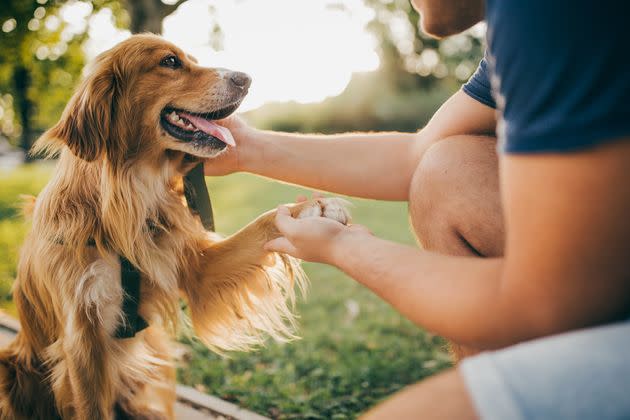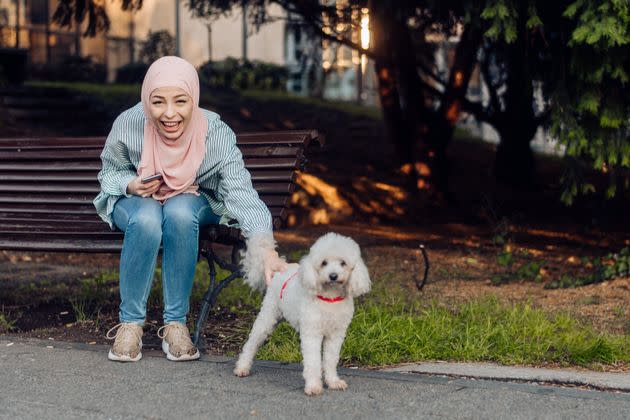6 Signs Of A Happy Dog, According To Veterinarians

Most dog owners would probably love to know what their pet is thinking. Unfortunately, our dogs can’t tell us, so it can be hard to know if they’re truly happy or just making do with their surroundings.
While no one can read a dog’s mind, veterinarians are the closest thing we have to dog interpreters ― and they say there are certain behaviors and patterns that can indicate if your dog is living a happy, content life. (And, no, tail-wagging does not necessarily mean that your dog is full of glee.)
Below, vets share how to tell if your dog is happy and offer tips on making your pooch happier:
They have their basic needs met.
It’s hard to be joyful if your basic needs aren’t met, and the same goes for dogs.
“When I think of ‘happy,’ I think about welfare and that a dog has all their needs met,” said Dr. Kate Anderson, a veterinary behaviorist at Cornell University’s Duffield Institute for Animal Behavior in New York. “And that idea goes back quite a ways, to the ’60s.”
Anderson referenced the five freedoms of animal welfare — freedom from hunger and thirst; freedom from discomfort; freedom from pain, injury and disease; freedom to exhibit normal behavior; and freedom from fear and distress.
Nowadays, our understanding of dogs’ happiness goes beyond simple criteria like these, Anderson noted. (The same goes for happiness in humans, as evidenced by the thousands and thousands of self-help books on the topic.) But having their basic needs met is a step in the right direction.
They have relaxed body language.
“Happy dogs should have very loose body language,” Anderson said. “They shouldn’t have any tension. Their ears shouldn’t be pulled back. You shouldn’t see the whites of their eyes. Their tail should be at, depending on their breed, a normal angle to their body like 90 degrees, or just relaxed.”
Dr. Kristi Flynn, a primary care veterinarian at the University of Minnesota’s College of Veterinary Medicine, added that their weight should be evenly distributed on all four limbs. They shouldn’t be leaning back or standing with a paw up.
“We can think of the dogs just laying out in the yard in the sun, just laying on their side with their body all relaxed,” Flynn said. “That’s, to me, a sign of a happy or content dog.”
Anderson added that your dog is likely pretty happy if their movements are “loose and they look like noodles.”
They have relaxed facial expressions.
Dogs and humans have similar facial muscles, Flynn explained, so certain facial expressions can show if they feel content.
These include “the absence of a furrowed brow,” she said, and whether they look “relaxed around the eyes, relaxed around the mouth.”
Think about it: When you’re upset, your mouth probably droops and you may squint your eyes. This is not the look of a happy person (or dog). So if you notice a calm, relaxed look across your dog’s face, it’s safe to say that they’re in a good mood.
There’s a set routine for your pet.
Just like toddlers and young children, dogs like things to be predictable, Anderson said. “It’s not that they don’t want novelty and excitement, but they don’t want the whole world to be constantly different,” she noted.
According to Anderson, the toughest times of the year for dogs are when human schedules change. This can happen amid the holidays, a big trip or a return to the office.
While vacations are of course allowed ― and a return to the office is likely out of your control ― it’s important to stick to a routine as much as possible with your pet and to establish a new routine when change has to happen.

They take part in enrichment, like exercise, training or using puzzle toys.
Getting your pooch plenty of exercise is important; not only can it help keep their weight in a healthy range, but it can also provide them with much-needed enrichment.
“I categorize exercise under enrichment, and enrichment is a really broad topic,” Anderson explained. “It’s kind of the things in your life that are your self-care.”
Beyond just exercise, this can include mental stimulation. So for dogs, physically moving around counts, as does engaging with a puzzle toy or taking part in a training class.
“I advocate for and use evidence-based, humane training methods with my dogs and recommend that clients and pet owners use the same, just because it shows that it reduces stress and conflict,” Flynn said. Training can also keep your dog’s mind sharp no matter how young (or old) they are, Flynn noted. So, just because your pup is housebroken and knows their basic commands doesn’t mean that the learning needs to stop.
“That can really bring them joy, and it’s a great way to bond with your pet and really strengthen that relationship,” Flynn said.
They have an owner who is willing to advocate for them.
Your dog may exhibit body language that shows how they’re feeling. However, they can’t flat-out tell someone to back off — but you can.
It’s OK to voice your dog’s comforts and discomforts to people around you, whether they’re your loved ones or people on the street, Flynn said.
All dogs have their own personality; some are social, while others are introverted, she said. If you end up with a shy dog, it’s important to advocate for them by letting people know your pet’s preferences. For example, you might ask strangers not to pet your dog or tell friends to leave your dog alone when they come over.
“It can be hard to try to manage the social pressure from the human side and make sure that your dog is comfortable,” Flynn said. “I think sometimes I’ve inadvertently let my dog be in a position where he wasn’t as comfortable as maybe he could have been.”
This isn’t something that’s learned right away, but Flynn said it would be nice, overall, if folks could give each other’s dogs a little more space.
“People have good intentions, but actually giving dogs space and just respecting their boundaries, I think, is important,” she said.
Just as humans are allowed to have preferences, dogs are too. And if you force your pet to go against their natural instincts or their one-of-a-kind personality, you’ll be taking away from their joy — and who in the world would want to do that?


